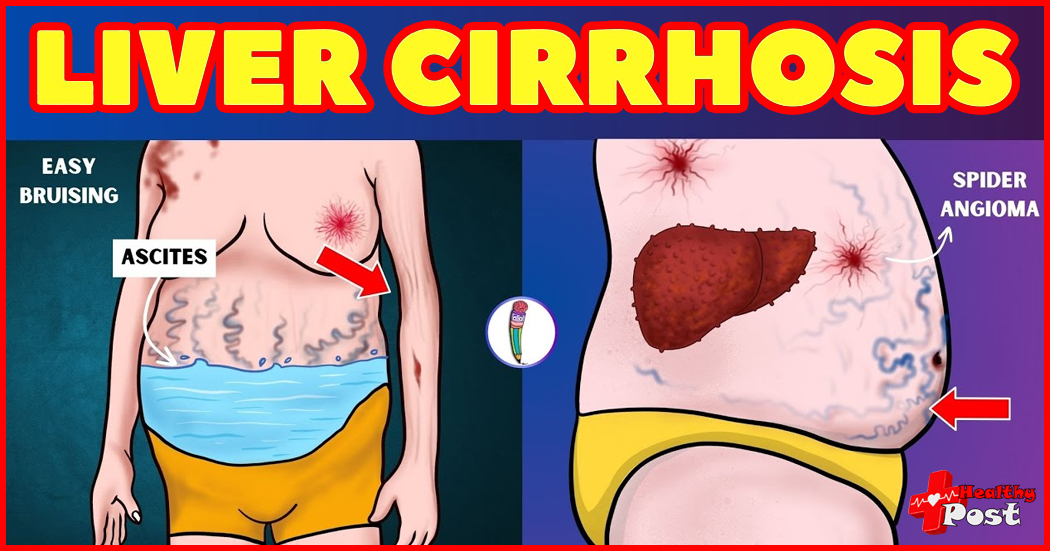
Learn what cirrhosis is in one article? Causes and How to Prevent
Cirrhosis is a disease that causes severe scarring and damage to the liver. Healthy tissue in the liver is replaced by hard scar tissue, making it difficult for the liver to function properly.

In most cases, symptoms will not occur unless cirrhosis is advanced. If symptoms occur, common symptoms are nausea, fatigue, loss of appetite, and abdominal pain . Unfortunately, there is currently no cure for cirrhosis. However, there are several treatments that can help reduce your symptoms and prevent complications.
There are currently 7 million patients with liver cirrhosis in China. Although cirrhosis can happen to anyone, people between the ages of 45 and 54 are more likely to develop it. Understanding the symptoms of cirrhosis and knowing when to seek medical attention can help improve your condition and improve your overall quality of life.
Common symptoms of cirrhosis
There are usually no symptoms in the early stages of cirrhosis. However, as scar tissue worsens, patients may experience the following symptoms:
- nausea
- fatigue
- Loss of appetite
- lose weight
- Slight pain in the upper right side of the abdomen
As liver function worsens, you may also develop the following complications:
- swelling of legs, feet, or ankles
- Fluid in the stomach
- Easy bruising and bleeding
- confusion
- Yellowing of the eyes and skin (called jaundice)
- Darker urine
- low libido
- Hepatic encephalopathy, or a buildup of toxins in the brain
Causes of cirrhosis
It most commonly results from chronic liver injury. Liver damage can lead to inflammation and scar tissue formation – a process known as liver fibrosis. Excess scar tissue can disrupt the normal shape and function of the liver, leading to cirrhosis.
- Some factors that lead to cirrhosis include:
- Alcoholic liver disease: Long-term excessive drinking can cause liver inflammation and eventually lead to cirrhosis.
- Non-alcoholic steatohepatitis (NASH): This is a form of non-alcoholic fatty liver disease (NAFLD) that causes inflammation and fat accumulation in the liver. Without proper treatment, cirrhosis of the liver may develop.
- Viral hepatitis: Many people become infected with hepatitis B or C, which causes cirrhosis of the liver. About one-quarter of people with chronic hepatitis C will develop cirrhosis.
- Bile duct disease Bile duct disease blocks the flow of bile to the small intestine. This causes bile to back up into the liver, leading to cirrhosis.
- Genetic disorders: Certain genetic disorders, such as Alpha-1 antitrypsin deficiency, hemochromatosis, Wilson’s disease, and autoimmune hepatitis, increase the risk of it.
- Certain drugs: Metamizole (ibuprofen) and other drugs that help reduce pain and fever can sometimes cause damage to the liver if used too often. To prevent it, follow your doctor’s advice and take medications when necessary.
Diagnosis of cirrhosis
If you suspect that you have symptoms of liver cirrhosis, it is best to go to the hospital for examination. During the visit, the doctor will ask about personal and family medical history, symptoms, lifestyle habits, and whether you are taking any medications. After learning more about your medical history, your doctor will prescribe tests to better understand your symptoms. These tests include liver biopsies, imaging tests, and blood tests.
liver biopsy
A liver biopsy involves taking a sample of liver tissue and examining it under a microscope to see the extent of scarring. During a liver biopsy, a thin needle is inserted into the liver and a small piece of tissue is removed. During the procedure, local anesthesia is generally administered to reduce pain.
Imaging detection
Imaging tests are used to check for structural changes and scarring in the liver. During the diagnosis, they may use any of the following tests:
- Computed tomography (CT): Uses special X-ray equipment and a computer to create multiple images of the liver.
- Magnetic resonance imaging (MRI): Uses powerful magnetic fields and radio waves to create detailed images of the liver and check for damage.
- Ultrasound uses sound waves to create images of the liver. Healthcare providers can use Doppler ultrasound to check blood flow in and out of the liver, or use ultrasound elastography to determine the stiffness and scarring of the liver.
blood test
In some cases, doctors may also order blood tests as part of the diagnosis. These checks include:
- Liver function tests to check for abnormal liver enzyme (protein) levels
- Complete blood count, which can show signs of liver infection and anemia
- Anti-smooth muscle antibody (SMA), anti-nuclear antibody (ANA), and anti-mitochondrial antibody (AMA) tests, which all test for autoimmune liver disease.
- Viral hepatitis testing to check if you have hepatitis B or C
Treatment of cirrhosis
Currently, there is no specific treatment that can cure liver cirrhosis. However, there are several treatment options available to treat the underlying cause of the disease.
Depending on the cause of it. Your doctor may recommend certain treatments, such as medications and lifestyle changes, to prevent the condition from getting worse.
Treating the underlying cause of cirrhosis
| root cause | |
|---|---|
| alcohol related cirrhosis | Reduce alcohol intake and participate in an alcohol rehabilitation program |
| hepatitis | Taking antiviral medications to treat hepatitis B or C |
| Nonalcoholic steatohepatitis (NASH), or accumulation of fat in the liver | Eat healthily, exercise regularly, and maintain a healthy weight |
| autoimmune hepatitis | Using immunosuppressant drugs to reduce immune system activity and inflammation |
change lifestyle
In addition to treating the underlying cause of its, your doctor may recommend lifestyle changes to help improve symptoms and reduce the risk of complications. These changes include:
- Avoid alcohol altogether
- quit smoking
- exercise regularly
- low salt diet

Surgery
Advanced cirrhosis sometimes progresses to liver failure. In this case, doctors may consider a liver transplant — especially if you have severe scarring or extremely low liver function. Generally, a liver transplant is considered only if other treatment options have not helped improve symptoms or slow disease progression.
Remember: Before having a liver transplant, you will need to undergo extensive testing to determine if you are a candidate for a liver transplant.

How to prevent cirrhosis of the liver
There are steps you can take in your daily life to reduce your risk of cirrhosis. In order to prevent the occurrence of liver cirrhosis, you should pay attention to the following points in your daily life:
- Limit alcohol intake
- Eat a diet based on fresh fruits, vegetables and lean protein
- Exercise for 30 minutes every day
- Get Hepatitis B Vaccination
- Avoid eating undercooked fish and meat
Complications of cirrhosis
If cirrhosis progresses or is diagnosed in an advanced stage, you may be at increased risk of complications, including:
- Portal Hypertension: Portal hypertension, the most common and serious complication of it, occurs when blood flow is slowed and blocked by scar tissue, leading to high blood pressure.
- Ascites: Fluid in the abdominal cavity: Intestinal and liver infections can occur due to accumulation of fluid in the abdominal cavity.
- Varicose veins: Causes dilation of veins in the stomach, intestines, or esophagus, which can cause internal bleeding if the veins rupture
- Infections: People with cirrhosis are more susceptible to serious infections, such as pneumonia or urinary tract infections
- Hepatic encephalopathy: When cirrhosis of the liver makes it difficult for the body to remove toxins, the toxins can accumulate in the liver and travel to the brain, causing confusion or difficulty thinking.
- Liver Cancer People with it is at higher risk of developing liver cancer
- Malnutrition: Cirrhosis can make it difficult to absorb and process nutrients, making malnutrition, loss of appetite, and unintended weight loss more likely.
- Liver Failure Severe cirrhosis may cause severe damage to the liver, leading to liver failure and loss of normal liver function.
Living with cirrhosis
The life expectancy of a person with cirrhosis depends on the stage of cirrhosis at which it is diagnosed and the treatment options available. Generally speaking, the life expectancy of a person with asymptomatic cirrhosis (or a person without symptoms) is 12 years or more. However, patients with advanced cirrhosis or it’s related complications tend to have a shorter life expectancy of just two years.
Although cirrhosis cannot be reversed, by taking steps such as abstaining from alcohol, exercising regularly, eating a healthy and balanced diet, and following a treatment plan, it is possible to slow the progression of cirrhosis while helping to control the condition and reduce the risk of complications. .
quick review
Cirrhosis is scarring, inflammation and damage to the liver. Scar tissue replaces healthy liver tissue and affects the liver’s function. There are many factors that can lead to cirrhosis, including drinking too much alcohol, hepatitis infection, bile duct disease, or certain genetic conditions.
Generally speaking, there are no symptoms in the early stages of this. But as the disease progresses, you may experience symptoms such as nausea, fatigue, and loss of appetite. If you have symptoms of it, or are at risk of developing cirrhosis, be sure to go to the hospital for a checkup to get the correct diagnosis and treatment plan to prevent further complications.


2 thoughts on “Learn what cirrhosis is in one article? Causes and How to Prevent”